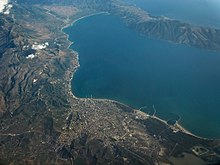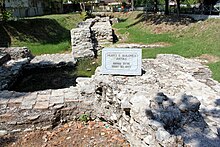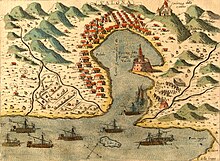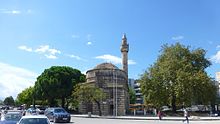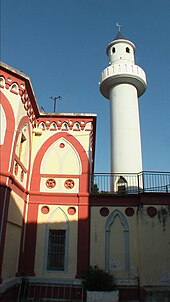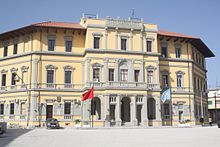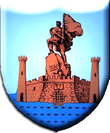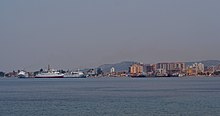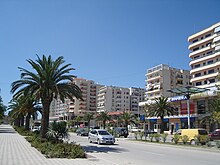Vlora
|
Vlorë Vlora |
||

|
||
|
Coordinates: 40 ° 28 ' N , 19 ° 29' E |
||
| Basic data | ||
|---|---|---|
| Qark : | Vlora | |
| Municipality : | Vlora | |
| Height : | 25 m above sea level A. | |
| Area : | 616.85 km² | |
| Residential place : | 79,513 (2011) | |
| Bashkia residents : | 130,827 (2011) | |
| Population density (Bashkia): | 212 inhabitants / km² | |
| Telephone code : | (+355) 033 | |
| Postal code : | 9401-9404 | |
| Politics and administration (as of 2019 ) | ||
| Mayor : | Dritan Leli ( PS ) | |
| Website : | ||
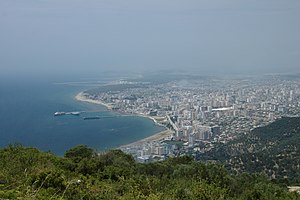 View of Vlora from Kanina (2015) |
||
Vlora ( Albanian also Vlorë ; Greek Αυλώνα Av̱ló̱na ; Italian Valona ; Turkish Avlonya or Avlona ) is a port city in southern Albania on the Strait of Otranto , the narrowest part of the Adriatic . With 79,513 (2011 census) to 108,944 inhabitants (self-reported 2009), it is the third largest city in the country. The bay of Vlora and the beaches near the city are popular tourist destinations . The coastal city is the seat of the authorities of the same name Qark , which the surrounding countryside and the Albanian Riviera and the regions of Saranda and Delvina includes. The city is also the official seat of a Bashkia .
On November 28, 1912, Albania declared in Vlora from the Ottoman Empire for independently and for a short time Vlora was the capital of the new state.
geography
location
Vlora is located on the shores of the Adriatic Sea, which here forms the Bay of Vlora. At the exit, around 15 kilometers west of the city, is Sazan , the only large island in Albania. It is only about 90 kilometers to Italy .
The city center is about a kilometer from the seashore. The city center and the Skela port area have grown together for decades. Skela is also home to important facilities such as the university and the football stadium. The settlement area also extends further south along the shore of the bay to Ujë i ftohtë . In the west of the city there are larger industrial and port facilities.
The urban area is nestled between the sea, the lagoon of Narta and hills, the foothills of the coastal mountains. The Shushica (also called Lumi i Vlorës ) flows just a few kilometers east of Vlora and flows into the Vjosa at the village of Armen . There are no significant bodies of water in the city itself. From Vlora to the north, the approximately 150 kilometers long coastal plain of Albania extends. In the south on the other side of the bay the Karaburun peninsula rises to over 800 meters above sea level. The hills in the east of the city are foothills of the Ceraunic Mountains , which reach heights of more than 2000 meters south of Vlora.
The next larger cities are Fier in the north, Ballsh in the north-east, Tepelena in the east and the small town of Himara in the south-east on the Ionian Sea .
local community
Since 2015, the surrounding communities Orikum (5503 inhabitants), Novosela (8209 inhabitants), Qënder (7621 inhabitants, including the villages of Narta and Zvërnec ) and Shushica (3981 inhabitants) belong to the Bashkia Vlora - coastal and mountain areas north and south of the city . The whole municipality has 104,827 inhabitants (as of 2011).
climate
As usual in coastal cities, Vlora has a Mediterranean climate . The average maximum temperature in summer is 32 ° C, in winter the average minimum temperature is 2 ° C. The most precipitation falls in November with 152 millimeters, in August it is only 13 millimeters (average values).
population
Vlora is the third largest city in Albania after Tirana and Durrës . At the end of the communist era in 1989 it had 71,662 inhabitants. In 2001, 77,691 people lived in the city. But by 2007 the number rose dramatically: 91,711 inhabitants were counted. The trend continues to this day, in 2010 an estimate for Vlora resulted in around 110,000 inhabitants. The 2011 census showed only 79,513 inhabitants. The reasons for the population growth despite simultaneous emigration and the resulting expansion of the urban area are different. However, it is mainly the unemployment and poverty in the rural areas, especially in the east, that drive people to Vlora in the hope of improving their quality of life here. But economic growth, especially in the tourism industry, also attracted a large number of workers, entrepreneurs and traders.
A Greek-speaking minority lives in the village of Narta .
religion
The largest religions in Vlora include Islam and Orthodox Christianity .
A Bektashi - Tekke lies above the city .
A small Catholic minority of the Albanian Greek Catholic Church practices the Byzantine Rite . The Apostolic Administration of Southern Albania has its seat in Vlora.
From the 16th century onwards there was Albania's largest Jewish community in the port city, but the majority of them have emigrated to Israel or the United States since the 1990s .
history
Antiquity
Thanks to its strategic position at the entrance to the Adriatic Sea, the Bay of Vlora , which forms a natural harbor, was a trading center sought after by many peoples. For the development of the city in antiquity, this sequence now results: a change of location from Treport to Vlora around the 1st century BC. And an immigration in the 6th century AD
First there was a settlement seven kilometers northwest near the tip of the Treport peninsula. At the beginning of the 20th century, excavations were carried out here, but it was only since the excavations by Vasil Bereti around 1990 that various phases of settlement from the 7th century BC can be identified. Until the 2nd century BC Prove. Remnants of a 600-meter-long fortification wall running parallel to the coast were exposed. The city, whose name Daulia is assumed, experienced its heyday between the 4th and 2nd centuries BC. At the same time , Byllis , which was developed into the capital of an Illyr tribe who settled inland a few kilometers away , had its next port in Daulia. The place was in the 1st century BC. Abandoned BC.
Roman sources from the 2nd century AD mention a stopover on the trade route along the coast between Dyrrhachium and Buthrotum . Since parts of a city fortification from the 4th century AD were excavated near the Muradie Mosque in the old town in 1988 , this Roman aulon is believed to have been at the site of the present-day city. In the 5th century, Aulon became the seat of a bishop within these fortress walls . The walls were reinforced under Emperor Justinian (527-565). An immigration took place from Apollonia, which was abandoned in the 6th century .
Contested city in the Middle Ages
At the end of the 6th century, Slavs ravaged the city, and many residents fled to the island of Sazan . 1081 looted from Apulia from Normans in the fight against Byzantines the city. From Vlora they marched over the Via Egnatia to Constantinople . In 1204 Valona came to the despotate of Epirus and in 1258 the Hohenstaufen king of Sicily invaded Epirus and occupied Corfu and some coastal towns of Dyrrachium , Valona, Kanina , Buthroton . Michael II. Komnenos Dukas Angelos , despot of Epirus, managed to persuade Manfred to form an alliance by giving him one of his daughters, Helena , as a wife and giving as dowry what Manfred had already conquered. The Staufer rule in Albania was to be short-lived. After Manfred's death on February 26, 1266 in the battle of Benevento and the imprisonment of his wife Helena by Charles of Anjou , the latter claimed the inheritance of Manfred (Corfu and the coastal towns of Dyrrachium, Valona, Kanina, Buthroton).
In agreement with Pope Clement IV , Charles von Anjou concluded in the Pope's residence in Viterbo on May 24, 1267 and on May 27 with Wilhelm II of Villehardouin , the prince of Achaia ( Morea ) and with the Latin emperor who had been expelled from Constantinople Baldwin II of Courtenay signed an alliance of friendship and an agreement, the Viterbo Agreement , in which Charles received Helena's dowry, the lands between Corfu and Dyrrachium, which he saw as a legitimate legal claim.
From February 21, 1272 Valona belonged to the Regnum Albaniae founded by Charles of Anjou . Castellan was Giacomo Baliniano "[...] Iacobi de Baliniano castellani castri nostri Canine et Avallone [...]"
In 1343 Valona was conquered by Serbs and in 1417 it was the first Adriatic port to be plundered by the Ottomans . Subsequently, Valona was recaptured by the noble Albanian family Arianiti and in 1478, ten years after the death of the national hero Skanderbeg , Ottoman troops conquered the city a second time.
Ottoman period
This is probably the reason why Sephardic Jews fled Spain from 1492 to Vlora and formed a larger community in the city. In 1520, 701 native and 531 Jewish families were counted under Turkish rule.
In 1537, under Suleyman I , the city was secured by fortress walls in the shape of an octagon with an edge length of 90 meters, partly with building material from ancient Daulia. Inside there was also a mighty round tower; by 1906 all fortifications were torn down and the material used to build the main road to the port.
The city was now called Avlonya by the Turks . The French nobleman Jean Carlier de Pinon describes in his work Mon voyaige en Levant, faict l'an 1579 (My journey to the Levant, made in 1579) the city of Vallona (Vlora), which is inhabited by Muslim, Christian and Jewish families . According to him, Vlora had five mosques with white minarets at that time. The port was used by many pirates from the area. In 1638 a Tunisian-Algerian corsair fleet invaded the Adriatic and withdrew to the Ottoman port of Vlora. A Venetian fleet bombarded the city, hijacked the pirate fleet and freed 3,600 prisoners.
Evliya Çelebi described Vlora and the surrounding area in detail in November 1670. Within the fortified city walls there were around 300 mud houses and a market square. Outside the city fortress, around 1,000 other stone houses - some of them multi-storey - are spread over a green level. Numerous different fruits and plants were grown there on a large scale.
In September 1690 Vlora went to the Republic of Venice and in 1691 again to the Ottomans. Under Ottoman rule, Vlora - now Avlona in Turkish - developed into the most important port city in the area of Albania and benefited above all from trade with Ragusa .
In 1810 Tepedelenli Ali Pascha was able to annex the city to his rule for a short time until the Ottoman sultan recaptured Vlora in 1822 when Ali Pasha was murdered.
Political center and military base in the 20th century

The recent history of the city has repeatedly been of great importance for all of Albania. During the Balkan Wars , the city was attacked by the Greek fleet on December 3, 1912 . But after Austria-Hungary and Italy asked Greece not to interfere in the strategically important Vlora, she was excluded from the war. In Vlora, Ismail Qemali proclaimed the independence of Albania on November 28, 1912 . Until the beginning of 1914, Vlorë was the seat of the country's first provisional government . In December of the same year, Italian troops occupied the port city. With the help of this base, Italy controlled the southern exit of the Adriatic. In 1920 the Italian troops were forced to withdraw by an uprising by the Albanians.
From 1939 to 1943 the city was again occupied by Italy, the submarine port on the offshore island of Sazan was the reason for the Allied bombs during the Second World War on the port and city. After the war, hardly any buildings from the Ottoman era were preserved. From 1956 until Albania's political break with Moscow in 1961, the Soviet Union maintained a naval base in Pashaliman at the southwest end of the bay. In the 1950s, this was the only Soviet military base in the Mediterranean .
Fighting Crime in the 1990s
More recently, the attention of the whole world has been on Vlora, when in January / February 1997 the unrest that led to the overthrow of the government and anarchic conditions spread from here to all of Albania.
In the 1990s, Vlorë became a center of smuggling across the Adriatic. The Strait of Otranto is only a little over 70 kilometers wide. With speedboats , smugglers can reach mainland Italy in a few hours. The mafia thus transported drugs and sometimes weapons , but especially people (refugees from Albania and Asia and women for prostitution ) to Western Europe . There were repeated accidents in which several refugees drowned. The Albanian authorities are currently fighting organized crime with the support of Italians, Germans and Americans .
Tourist center
From the 2000s the political situation in the city improved enormously and numerous hotels , restaurants , bars and discos emerged . In addition, beaches were created and roads expanded. It is believed that most of the money for the tourism sector came from drug , gun and human trafficking in the 1990s. Many buildings were erected without building permits, so they were demolished by a municipal action in the late 2000s.
Today Vlora is the tourist center of southern Albania, next to Saranda . Summer tourism in particular has become an important industry in the coastal city. But other sectors, especially in the energy supply sector, now offer more jobs.
Culture
Vlora is a cultural center of southern Albania: important and large institutions are here. Among the best known are the Petro Marko Theater (built in 1962) and the Shevqet Musaraj Library (1946). Vlora is also the center of the Labëria cultural region ; so the inhabitants are usually called Vlonjatët and Labët .
Cityscape
From the center of the new town near the port with its apartment blocks, hotels and banks, the wide main street leads 1.5 kilometers north to the old part of the city around the independence monument. Short sections of the medieval city wall can still be seen in the vicinity. Quickly built apartment blocks stretch the city north along the coast and west of the main road.
After the collapse of communism, many residents of Vlora lost their jobs. Smuggling across the Straits of Otranto developed and a lot of illegal money flowed into the city, which is believed to have been invested in luxury properties - hotels or boutiques. Since the change of government in September 2013, more and more illegal buildings have been demolished on the coast between Vlora and Orikum . By 2015, a beach promenade ( Lungo Mare ) with parks, sports fields and playgrounds as well as a grandstand for various cultural events is to be built along it .
Attractions
- The Muradie Mosque in the city center from 1542 was the only one of the Ottoman mosques to survive the wars and earlier an earthquake in 1851.
- Independence Monument
- Independence Museum
- historical Museum
- Ethnographic museum with everyday objects from households and handicraft businesses as well as folk clothing
- Bektaschi - Tekke on the Kuz Baba hill
- The Orthodox monastery of Zvërnec is located on a small island in the lagoon of Narta .
- Attractions in the surrounding area are also five kilometers away on a hill and the ancient path from Aulon to Amantia situated castle Kanina with wall remains of Illyrian (4th century BC. Chr.) Justinian (6th century. Chr.) Byzantine (11th century) and Ottoman times (16th century); after that the importance of the place declined due to the construction of the fortress in Vlora.
- The ancient Oricum , near which the port of Pashaliman was built in Ottoman times .
theatre
The first traces of a theater in the area can be found in the ancient city of Oricum , which lies south on the Bay of Vlora .
In November 1962 the first theater was opened in Vlora on the occasion of the 50th anniversary of Albania's independence in 1912. It is named in honor of Petro Marko , a major Albanian author.
education
The University of Vlora , named after Ismail Qemali, was founded in 1994. As a result, the range of subjects has been steadily expanded.
The Greek Conservatory has had a branch in the city since 2008.
media
With Radio Vlora , the city has a radio station reporting on the region, which mainly offers music for younger people in its program.
Sports
The local football club KS Flamurtari Vlora plays in the first Albanian league . He plays his home games in the Flamurtari Stadium .
politics
legislative branch
The city council (Alb. Këshilli Bashkiak ; Ger. "Kommunalrat") takes on the tasks of legislation . He is elected by the residents of the Bashkia for a term of four years. In the Bashkia of Vlorë, the city council consists of 51 members. The 2019 elections were boycotted by some opposition parties. In the last elections in 2015 , the council seats were divided between the following parties:
| Political party | Seats elections 2015 | Seats elections 2019 |
|---|---|---|
| PS | 18th | 47 |
| PD | 9 | boycott |
| LSI | 5 | boycott |
| PDIU | 2 | boycott |
| FRD | 1 | - |
| PBK | 1 | - |
| PDK | 1 | - |
| PDS | 1 | 1 |
| PEISH | 1 | boycott |
| PR | 1 | boycott |
| Psd | 1 | 1 |
| BD | - | 2 |
executive
The mayor (alb. Kryetari i Bashkisë ; actually "Bashkia President") takes on executive tasks together with his cabinet. From 2007 to 2015 Shpëtim Gjika ( PS ) was mayor of Vlorë ; he was re-elected in the 2011 elections. He is the first confirmed mayor of the city since 1990. In the 2015 elections Dritan Leli was elected, who was re-elected in 2019 .
Judiciary
The city is home to the Vlora Court of First Instance and the Vlora Court of Appeal.
coat of arms
The coat of arms represents the old fortress in the center, which is now overbuilt by the city center. On top of it is a rock engraved with the year 1912, the year of Albania's independence. Ismail Qemali is waving an empty flag on the rock. The fortress is surrounded by the waters of the Adriatic Sea.
diplomacy
Italy maintains a consulate general in Vlora , which is responsible for the Qarks Berat , Gjirokastra and Vlora .
Twin cities
Economy and environment
The port is the second largest in the country. In the years after 2001, however, the turnover of goods steadily decreased and in 2004 it reached 300,000 tons, only a tenth of the amount from the port in Durrës . Jobs have been created in tourism in recent years . The new hotels around the Bay of Vlora are mainly used by local beach holidaymakers.
Olive plantations
Olive trees are cultivated around the city . The olive oil obtained from it is produced and partly also exported . The best-known company is Aulona , which also exports organically produced olive oil to Switzerland .
Environmental damage
On the coast five kilometers northwest of the port is the city's industrial area. There, ruthless industrialization in the post-war communist era has made Vlora one of the five areas of Albania most affected by environmental damage. The cause is a chemical company that started operations in 1970 to produce alkali chlorides and polyvinyl chloride (PVC). The factory was closed in 1992 and destroyed during the aforementioned unrest in 1997. What remains are concrete ruins and a concentration of mercury in the soil that is a thousand times higher than the EU limit value . The soil is also contaminated by chlorinated hydrocarbons . Wastewater treatment was not planned. The immediate victims are newly settled residents in the vicinity and the Narta lagoon as one of the most important wetlands to the north.
Industrial park project
At this point, an oil-fired thermal power plant ( Thermo Power Plant TPP ) was built. Loans of 110 million euros were promised by the World Bank and two major European banks. Citizens' initiatives criticize the project because of insufficient public participation, a lack of impact assessment for the environment and fisheries and fear negative effects on tourism. Despite several demonstrations in recent years and a World Bank study from July 2007, in which a reconsideration of the project was recommended, work on the site began in 2007 and the power plant was commissioned in a reduced form in 2011.
In connection with this power plant is a document created on the coast natural gas ( LPG ) and petroleum - terminal . The strategic plan also provides for the construction of the 900-kilometer oil pipeline from Burgas in Bulgaria via North Macedonia to Vlora, which has been advocated by Albania and the USA for many years .
traffic
Vlora is on the SH8 , which connects Fier in the north with Saranda in the south along the Albanian Riviera . Between Fier and Vlora there is a parallel motorway with the A2 ; however, this section of the national road is in poor condition. The SH8 then continues along the Bay of Vlora via Orikum and the Llogara Pass to the Albanian Riviera to Saranda. This section of the route is in good condition and connects the small coastal villages in southern Albania with the rest of the country.
The Hekurudha Shqiptare operates a train station in Vlora; the operation was stopped. From the 1920s to 1994, the Ferrovia Decauville a Valona light railway drove to Vlora, which brought bitumen from the Selenica mines to the port.
From the port of Vlora there is a ferry to Brindisi in Italy . In summer there are also occasional speedboats to Himara , Saranda and Corfu .
Personalities
Ismail Qemali (1844–1919) is probably the most famous personality in the city of Vlora. He took part with other Albanian patriots in the Rilindja movement, which first aimed at the autonomy and then the independence of Albania. On November 28, 1912, Qemali proclaimed the independence of the Republic of Albania in Vlorë. Qemali came from the local extended family of the Vlora , from which many other personalities emerged. Other well-known sons of the city included the three Ottoman grand viziers Çelebi Lütfi Pascha (1468–1564), Kemankeş Kara Mustafa Pascha (1592–1644) and Avlonyalı Mehmet Ferit Pascha (1851–1914). Igli Tare (* 1973), one of the most successful soccer players in Albania, and Alban Skenderaj (* 1982), a popular pop musician in Albania, Kosovo and North Macedonia, are other personalities in the city.
literature
- Alain Ducellier: La Facade maritime de l'Albanie au moyen age. Durazzo et Valona du 11e au 15e siecle. (= Documents et recherches sur l'economie des pays byzantins, islamiques et slaves et leurs relations commerciales au moyen age. 13). Thessaloniki 1981.
- Zeko Braho: Vlora në rrjedhat e historisë. Tirana 1997.
- Johann Berner: Cultural-historical reports on the port cities of the Balkan Peninsula: Skutari, Durazzo, Valona. Leipzig 1917.
- Zenepe Luka: Vlora. Shenime. Tirana 1998 (on the riots in Vlora 1997)
Web links
- Website of the municipality of Vlora (Albanian)
- Port of Vlora (Albanian)
- Valona - a Soviet Mediterranean fortress. (PDF; 146 kB) Social Democratic Press Service, March 2, 1950, p. 3.
Individual evidence
- ↑ a b c Ines Nurja: Censusi i popullsisë dhe banesave / Population and Housing Census - Vlorë 2011 . Results Kryesore / Main Results. Ed .: INSTAT . Pjesa / Part 1. Adel Print, Tirana 2013 ( instat.gov.al [PDF; accessed April 14, 2019]).
- ↑ Guida e trashegimnisë kulturore të Qarkut Vlorë. (No longer available online.) Archived from the original on December 18, 2012 ; Retrieved January 1, 2012 (Albanian). Info: The archive link was inserted automatically and has not yet been checked. Please check the original and archive link according to the instructions and then remove this notice.
- ↑ Weather, climate, weather forecast for Vlorë. zoover.at, accessed on October 12, 2011 .
- ↑ Miranda Vickers: Shqiptarët - Një histori modern . Bota Shqiptare, 2008, ISBN 978-99956-11-68-2 , Hyrje , p. 16 (English: The Albanians - A Modern History . Translated by Xhevdet Shehu).
- ↑ Peter Bartl: Albania - History. Retrieved April 8, 2018 .
- ↑ Alain Demurger: The last Templar: life and death of the Grand Master Jacques de Molay . CH Beck, Munich 2015, p. 56 ( limited preview in Google Book search).
- ^ Jean Dunbabin: Charles I of Anjou: Power, Kingship and State-Making in Thirteenth-Century Europe . Routledge, London / New York 1998, ISBN 978-0-582-25370-4 , pp. 90 (English, limited preview in Google Book search).
- ^ Robert Elsie: A Biographical Dictionary of Albanian History . IB Tauris, London / New York 2012, ISBN 978-1-78076-431-3 , pp. 81 f . (English, limited preview in Google Book Search).
- ^ Camillo Minieri Riccio: Genealogia di Carlo I di Angiò: prima generazione . Vincenzo Priggiobba, Naples 1857, p. 140, Document No. XIV (Italian, Text Archive - Internet Archive ).
- ^ Domenico Forges Davanzati: Monumenti . In: Dissertazione sulla seconda moglie del re Manfredi e su 'loro figlioli, Filippo Raimondi . Filippo Raimondi, Naples 1791, p. XLVII, number LI (Latin, Text Archive - Internet Archive ).
- ↑ Miranda Vickers, p. 17
- ↑ Miranda Vickers, p. 19
- ↑ Uwe Rada: The Adria: Rediscovery of a place of longing . Pantheon Verlag, Mènchen 2014, ISBN 978-3-641-12545-5 , p. 201 ( online version in Google Book Search [accessed January 14, 2017]).
- ^ History of Vlora. Bashkiavlore.org, accessed on January 30, 2016 (slightly different figures can be found in Albert Ramaj: Rescue of Jews in Albania . In: David , No. 73, June 2007. Haroey Samer: Rescue in Albania , Brunswick Press, Cathedral City CA. 1997, ISBN 1-888521-09-0 ( blog.aacl.com ), which mentions 609 houses or households inhabited by Jews.).
- ↑ 1579 Jean Carlier de Pinon: Pirates in Vlora. Robert Elsie, accessed January 4, 2017 .
- ^ Robert Elsie : Kanina dhe Vlora nga udhëpërshkrimi e Evlija Çelebiut . In: Albanica Ekskluzive: revistë mujore për dije e kulturë . April 2007 (Albanian, elsie.de ).
- ^ Kenneth Meyer Setton: Venice, Austria, and the Turks in the Seventeenth Century . The American Philosophical Society, Philadelphia 1991, p. 375 (English, online version in Google Book Search [accessed January 14, 2017]).
- ↑ Miranda Vickers, p. 43
- ↑ Miranda Vickers, p. 114
- ↑ Vlorë prezantohet projekti i shëtitores (Vlora, project to the promenade will be presented). In: Top Channel . November 28, 2013, Retrieved November 30, 2013 (Albanian).
- ^ Teatro del dramma e varietà "Petro Marko" Vlorë. In: Antiarte. Retrieved September 23, 2012 (Italian).
- ↑ Historiku dhe aktiviteti i Teatrit "Petro Marko" Vlore. In: Bashkia Vlora. Retrieved September 23, 2012 (Albanian).
- ↑ Zgjedhjet Vendore 8 May 2011. In: Bashkia Vlora. Retrieved September 23, 2012 (Albanian).
- ^ Statute of the Bashkia Vlora. (PDF; 1.4 MB) Retrieved September 23, 2012 (Albanian).
- ^ Profile of the mayor. In: Bashkia Vlora. Retrieved September 23, 2012 (Albanian).
- ↑ Gjykata e Rrethit Gjyqësor Vlora. In: gjykata.gov.al. Retrieved April 19, 2018 (Albanian).
- ^ Website of the Consulate General Vlora. Retrieved January 4, 2017 (Italian).
- ↑ Olive oil from Vlora in Swiss shops. albinfo.ch, October 6, 2011, archived from the original on March 12, 2012 ; Retrieved October 11, 2011 .
- ↑ Albania's environmental wasteland and Post-Conflict Environmental Assessment - Albania . BBC News, April 27, 2001
- ↑ Photos of the factory ruins and a sewer that led directly into the sea Geotest BRNO ( Memento from October 17, 2007 in the Internet Archive )
- ↑ Bankwatch.org ( MS Word ; 54 kB)
- ↑ World Bank Study English ( MS Word ; 123 kB)
- ↑ Gjergj Erebara (Gazeta Shqip): TEC i i Vlorës fillon Pune me kapacitet të bird. In: Peshku pa ujë. October 28, 2011, accessed November 12, 2015 (Albanian).
- ↑ La Petrolifera Italo Albanese Sh.A.
- ↑ La Petrolifera Italo Albanese. In: PIR Group. Retrieved August 6, 2018 (Italian).
- ↑ Go-ahead for Balkan oil pipeline

